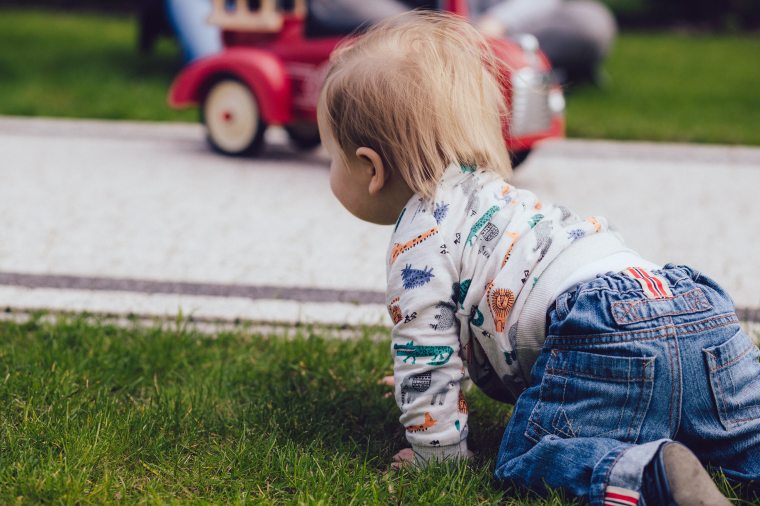Part of extending the life of children’s clothes is knowing how to deal with tricky stains. Sooner or later, kids will manage to get a whole cocktail of smudges on their clothes – and they seem to have a special talent for doing so on newly bought items… But don’t stress! We’ve created panic-proof guide on how to treat different types of stains.
Knowing how to treat stains doesn’t only save your garment, but the environment, too. It’s better to rub a stain off a sweater than to throw the whole thing in the laundry, because of all the water, energy and pollutants involved in machine-washing. So grab an old cloth and read on!
Before we start, here are some general stain rules to keep in mind:
Golden rules
1. Treat stains as soon as possible to prevent them from settling (except for mud).
2. Make sure to scrape off any possible excess before starting to wipe or rinse.
3. When running water over a stain, make sure to run water from the inside of the garment: this way the stain is forced ‘back out’, instead of being pushed even more deeply into the cloth.
4. Don’t rub too hard, but rather dab at stains, to prevent the fibres from being damaged.
5. After putting a stained item in the laundry machine, make sure to check the stain is completely gone before tumble-drying the item. The heat might make the stain settle.
6. Before using a cleaning solution, make sure to check how the fabric reacts on an inconspicuous part of the garment, like the inside of a sleeve.
1. Mud
Stamping on muddy surfaces is about every child’s favourite hobby. Resist the urge to throw these dirty clothes in the machine as soon as you get home, however: mud is one of those stains you should leave alone before treating. Don’t touch it, just let the mud dry and then brush off the soil once it’s hardened up.
Clean the remaining stain by soaking the fabric in a quart of warm water, mixed with a table spoon of white vinegar and a teaspoon of dishwashing detergent. After 15 minutes, rinse with water and let it stand for a while. If the stain persists, try sponging it gently with rubbing alcohol.
2. Tomato sauce
Whether it’s ketchup, spaghetti or barbecue sauce; eating always forms a great stain hazard. Tomato-based sauces can be notoriously hard to remove, but it’s not impossible. The most important thing with these types of stains is to use cold water. Start by using a liquid cleaning detergent and gently rubbing it into the stain, in circular motions (working inward).
If the fabric is white or colour-fast, use a mild form of bleach, like hydrogen peroxide, white vinegar or lemon juice. Put a little on a sponge and dab at the stain. Another great trick for tomato-based stains is to hang the cloth in the sun. UV-rays break down tomato stains, so after a few hours, the stain should have faded.

3. Grass
Whether they are an avid football player or just a little adventurer, every child is bound to end up with grass slipmarks on their knees at some point. The key here is cold water. Lots of it. Rinse thoroughly and let the stained area soften up. Then rub some laundry detergent into the stain.
If that isn’t sufficient, apply a small amount of rubbing alcohol, and – contrary to its name – don’t rub it too hard. Gently dab, then rinse, apply some more laundry detergent and proceed with a normal machine wash. If you don’t have rubbing oil, try nailpolish remover, hairspray or hand sanitiser.
4. Paint or marker
Did you turn your back for a second during a crafty afternoon? Or did your little artist-to-be return from kindergarten with a new design on his or her shirt? The first thing to do when discovering a paint or sharpie stain is find out whether the perpetrator is oil- or water-based. Luckily, most kids’ paints and markers are water-based, which means a little rub with a cleaning liquid followed by a normal machine wash should do the trick.
If the stain is oil-based, use some rubbing alcohol (or an alternative) first, then apply dishwashing liquid. This solution is designed to deal with grease. Proceed to wash as normal. If the paint has already dried, try scraping as much as possible off withthe back of a knife or a spoon before starting the cleaning process.
5. Blood
A cut, a fall, a nosebleed… Blood can be very stubborn once it’s dried up, so try and attack these stains as soon as possible. Soak the fabric in cold water, then rub the stain with a bar of soap. If the fabric is not very delicate and has a light colour, use a bit of bleach (hydrogen peroxide, white vinegar or lemon juice) or ammonia.
A mixture of baking soda and white vinegar might also work. Dry the garment in the sun and check the stain is completely gone before machine washing it; heat makes blood settle even more.
Did the above methods still not work? Don’t throw out the garment just yet! There are lots of creative ways to hide stains. Cover the area with a printed design, a funny patch or different piece of fabric, for example. Or consider transforming the piece of clothing by cutting off legs or sleeves, or making a dress into a t-shirt or a skirt. Even items that are beyond hope can often be reused for their fabric, so always try to recycle! The environment will thank you.

